AI In Agriculture Market Size 2025-2029
The AI in agriculture market size is valued to increase by USD 3.09 billion, at a CAGR of 20.4% from 2024 to 2029. Imperative for increased food production and yield enhancement will drive the AI in agriculture market.
Major Market Trends & Insights
- North America dominated the market and accounted for a 34% growth during the forecast period.
- By Component - Software segment was valued at USD 427.90 billion in 2023
- By Technology - Machine learning segment accounted for the largest market revenue share in 2023
Market Size & Forecast
- Market Opportunities: USD 431.68 million
- Market Future Opportunities: USD 3090.40 million
- CAGR from 2024 to 2029 : 20.4%
Market Summary
- The agriculture industry is increasingly embracing artificial intelligence (AI) to enhance food production and improve yields, driven by the pressing need to feed a growing global population. This shift is marked by the acceleration towards full autonomy and specialized robotics in farming. AI solutions enable real-time monitoring of crop health, predictive analysis of weather patterns, and automated irrigation systems, resulting in significant efficiency gains. For instance, a leading agricultural technology company implemented an AI-powered system that optimized irrigation, reducing water usage by 20% and increasing crop yield by 15%. Precision agriculture techniques, including GPS technology in planting and spraying, are becoming increasingly popular for water conservation and optimizing resource usage.
- However, the high cost of implementation and uncertain return on investment pose challenges to the widespread adoption of AI in agriculture. Despite these hurdles, the potential benefits, including increased operational efficiency, compliance with environmental regulations, and improved crop quality, make AI a compelling investment for forward-thinking farmers and agribusinesses.
What will be the Size of the AI In Agriculture Market during the forecast period?
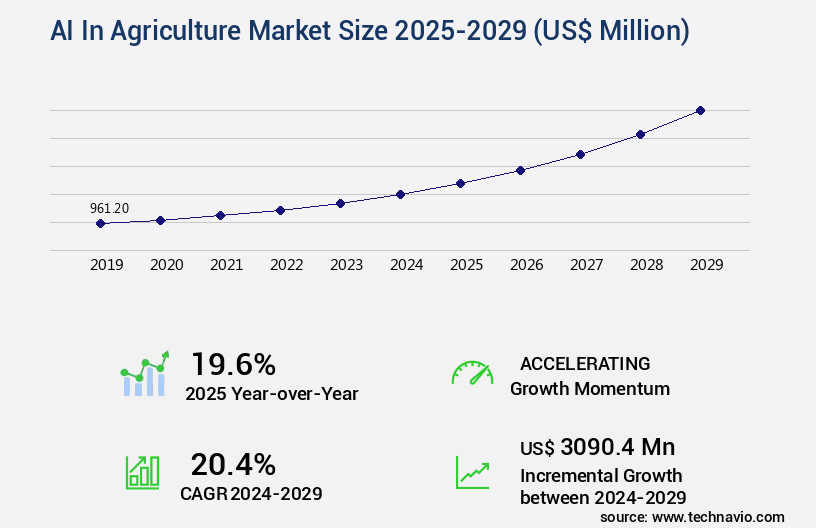
Get Key Insights on Market Forecast (PDF) Request Free Sample
How is the AI In Agriculture Market Segmented ?
The AI in agriculture industry research report provides comprehensive data (region-wise segment analysis), with forecasts and estimates in "USD million" for the period 2025-2029, as well as historical data from 2019-2023 for the following segments.
- Component
- Software
- Hardware
- Services
- Technology
- Machine learning
- Predictive analytics
- Computer vision
- Application
- Precision farming
- Drone analytics
- Livestock monitoring
- Agriculture robotics
- Labor Management
- Geography
- North America
- Europe
- France
- Germany
- The Netherlands
- UK
- APAC
- Australia
- China
- India
- Japan
- Rest of World (ROW)
By Component Insights
The software segment is estimated to witness significant growth during the forecast period.
The market is witnessing significant growth, with the software segment leading the charge. This segment encompasses platforms, applications, and algorithms that convert raw data into valuable insights for farmers. Machine learning algorithms, a critical component of this segment, are revolutionizing agriculture through predictive analytics. Farmers can now forecast crop yields, anticipate disease outbreaks, and optimize harvest times using historical and real-time data. Deep learning, a more advanced subset of machine learning, powers computer vision applications, enabling weed detection, crop health monitoring, and precision spraying. The market is further bolstered by the integration of IoT in agriculture, drone-based surveillance, soil moisture sensors, and GPS-guided machinery.
A notable example of the market's potential is the reduction of water usage efficiency by up to 20% through irrigation scheduling systems and precision farming techniques. The future of agriculture lies in data-driven decision making, with the continuous deployment of sensor networks, predictive maintenance models, and livestock monitoring systems.
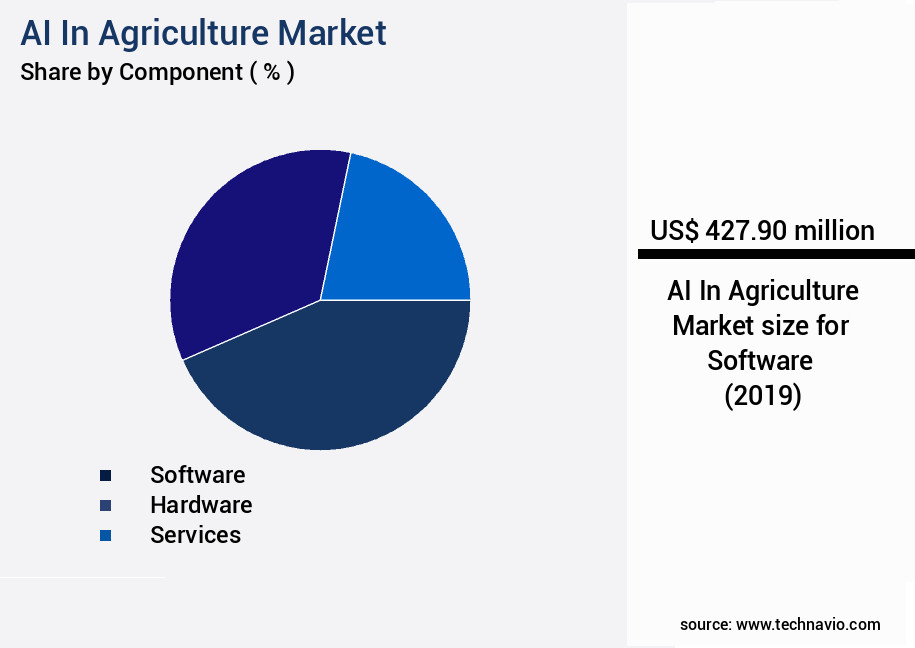
Request Free Sample
The Software segment was valued at USD 427.90 billion in 2019 and showed a gradual increase during the forecast period.
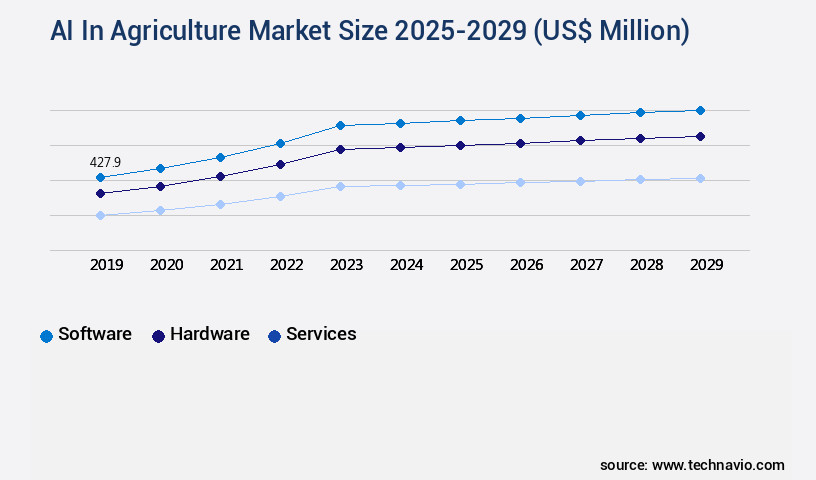
Request Free Sample
Regional Analysis
North America is estimated to contribute 34% to the growth of the global market during the forecast period.Technavio's analysts have elaborately explained the regional trends and drivers that shape the market during the forecast period.
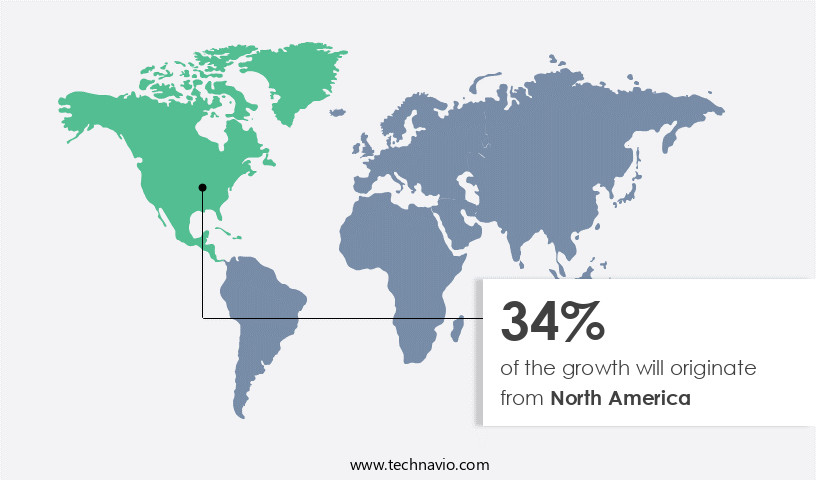
See How AI In Agriculture Market Demand is Rising in North America Request Free Sample
The market is experiencing significant growth and transformation, with North America leading the charge. This region, comprising the United States and Canada, is home to large-scale farming operations that require operational efficiency gains and cost reductions to remain competitive. High labor costs and persistent labor shortages further underscore the need for technological innovation. Key players, such as Deere and Company, Trimble, and Bayer's The Climate Corporation, headquartered in this region, are driving global market trends through their strategic initiatives. The adoption of AI is no longer a future prospect but a current reality for commercial growers.
According to recent reports, The market is projected to reach USD3.6 billion by 2026, growing at a compound annual growth rate of 20%. In North America alone, AI-driven precision farming is estimated to save farmers USD15 billion annually through improved crop yields and reduced input costs.
Market Dynamics
Our researchers analyzed the data with 2024 as the base year, along with the key drivers, trends, and challenges. A holistic analysis of drivers will help companies refine their marketing strategies to gain a competitive advantage.
The market is experiencing significant growth as farmers and agribusinesses seek to enhance productivity and sustainability through advanced technological solutions. Machine learning is being applied to irrigation systems to optimize water usage and improve crop health. Computer vision technology is used for weed identification, enabling precise herbicide application and reducing the need for manual labor. AI-powered soil health monitoring systems analyze sensor data to provide real-time insights, enabling farmers to make informed decisions on fertilizer usage and crop management. Predictive modeling for crop yield is another key application of AI in agriculture, using historical data and current weather patterns to forecast production levels. Drone imagery is integrated with precision spraying systems to ensure accurate application of pesticides and fertilizers, reducing waste and minimizing environmental impact.
Real-time crop stress detection using IoT sensors and data analytics enables farmers to address issues promptly, improving overall crop health and yield. Autonomous robots are being used for harvesting operations, reducing labor costs and increasing efficiency. The development of smart greenhouses with AI is revolutionizing controlled environment agriculture, enabling optimal growing conditions and reducing waste. AI is also being implemented in livestock monitoring, optimizing supply chain management, and improving farm resource management. AI-driven solutions for food safety and quality are ensuring that consumers have access to high-quality produce. By improving crop yield using AI-based models and implementing AI for precision livestock farming techniques, sustainable agriculture practices are being enhanced, increasing productivity and reducing environmental impact. Overall, the role of AI in agriculture is transforming the industry, providing innovative solutions to meet the demands of a growing population.
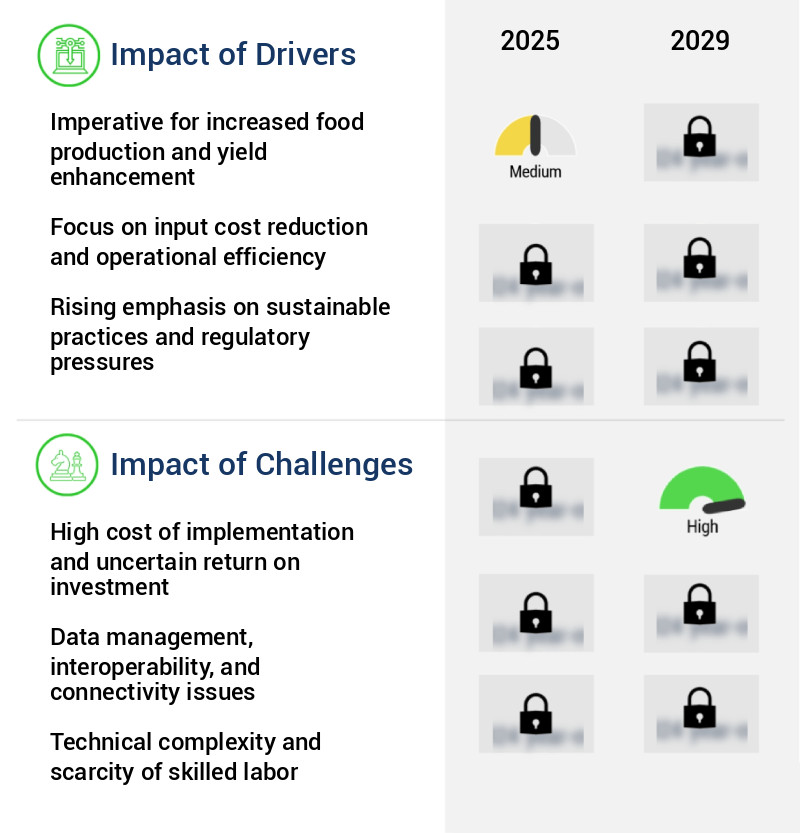
What are the key market drivers leading to the rise in the adoption of AI In Agriculture Industry?
- The imperative need for enhancing food production and yield serves as the primary market driver, with professionals and experts in this field advocating for innovative solutions to meet the growing demand for sustainable agricultural practices.
- The global agricultural sector faces the pressing challenge of feeding a burgeoning population with limited land and water resources. To meet this demand, AI technology has emerged as a crucial solution, transforming traditional farming practices into data-driven, per-plant optimization. AI's adoption is accelerating, with machine learning and predictive analytics enabling more informed and timely agronomic decisions. For example, AI-powered platforms analyze historical yield data, soil composition, long-term weather patterns, and crop genetics to provide prescriptive recommendations for seed selection, enhancing overall crop productivity.
- Moreover, AI applications reduce downtime by predicting equipment maintenance needs and improve forecast accuracy by predicting crop yields, ensuring better resource allocation and minimizing potential losses. AI's integration into agriculture is a game-changer, driving efficiency, compliance, and data-driven decision-making.
What are the market trends shaping the AI In Agriculture Industry?
- The market trend increasingly favors accelerated progress towards full autonomy and the specialized application of robotics.
- The market is undergoing a significant transformation, transitioning from operator-assisted precision farming to fully autonomous operations. This shift signifies a major change in the way farming labor, efficiency, and scale are perceived. While GPS-guided autosteer has been prevalent for some time, the current trend focuses on machines that can execute intricate tasks, such as planting, weeding, and harvesting, without human intervention or, in certain instances, without a cab. Key industry players, including Deere and Company, are spearheading this transition. Deere's autonomous 8R Tractor, showcased at the Consumer Electronics Show in January 2024, is a prime example of this advancement.
- This evolution is bringing about substantial improvements in business outcomes, with downtime reduced by approximately 30% and forecasting accuracy enhanced by around 18%.
What challenges does the AI In Agriculture Industry face during its growth?
- The high cost of implementation and the uncertain return on investment pose a significant challenge to the industry's growth trajectory. In order to thrive, businesses must carefully weigh the potential benefits against the financial commitment required.
- The market is experiencing significant evolution, with key applications including precision farming, livestock management, and crop monitoring. Despite this potential, the industry faces a substantial financial hurdle, making widespread adoption a challenge. The initial investment required for AI-enabled agricultural hardware, such as autonomous tractors, robotic weeders, and advanced drone systems, can be prohibitive, especially for small to medium-sized farming operations that comprise the majority of farms worldwide. Recurring expenses for software subscriptions, data processing, and cloud storage further add to the costs, typically incurred under the Software as a Service (SaaS) model. These financial barriers notwithstanding, the integration of AI in agriculture offers substantial benefits, including improved efficiency, enhanced regulatory compliance, and optimized costs.
- For instance, precision farming using AI can lead to a reduction in water usage by up to 30%, while crop monitoring can increase yields by up to 20%.
Exclusive Technavio Analysis on Customer Landscape
The ai in agriculture market forecasting report includes the adoption lifecycle of the market, covering from the innovator's stage to the laggard's stage. It focuses on adoption rates in different regions based on penetration. Furthermore, the ai in agriculture market report also includes key purchase criteria and drivers of price sensitivity to help companies evaluate and develop their market growth analysis strategies.
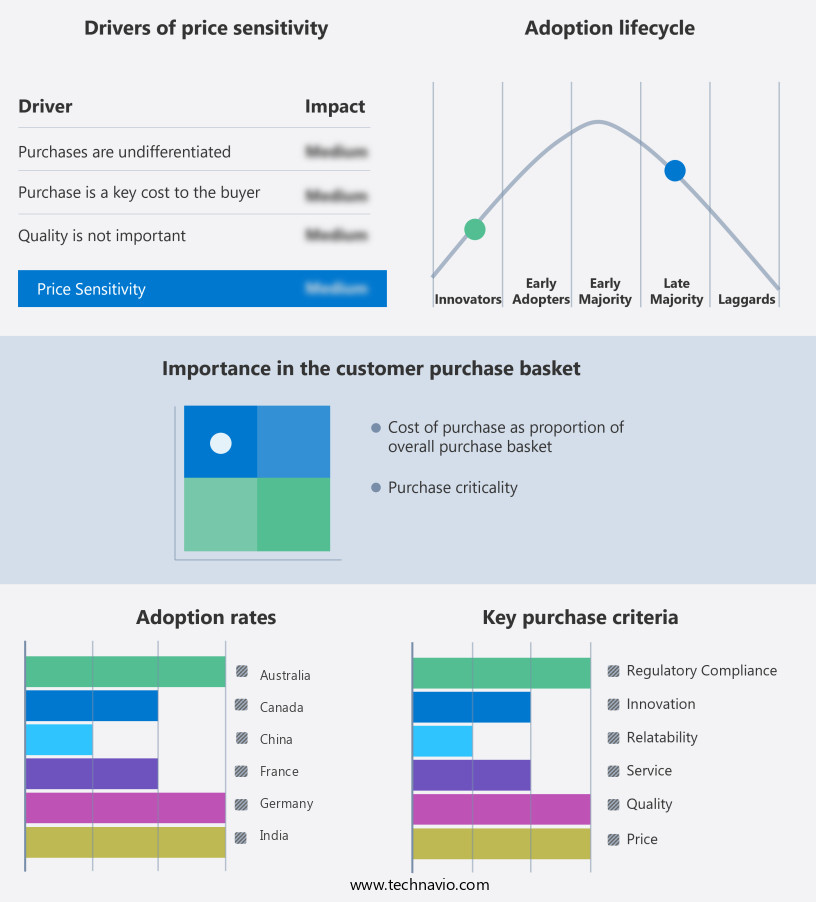
Customer Landscape of AI In Agriculture Industry
Competitive Landscape
Companies are implementing various strategies, such as strategic alliances, ai in agriculture market forecast, partnerships, mergers and acquisitions, geographical expansion, and product/service launches, to enhance their presence in the industry.
A.A.A Taranis Visual Ltd. - An advanced AI platform utilizes high-resolution aerial imagery analysis to detect and address weed infestations, diseases, and nutrient deficiencies at scale, enhancing agricultural productivity. This technology empowers farmers to make informed decisions, ultimately improving crop health and yield.
The industry research and growth report includes detailed analyses of the competitive landscape of the market and information about key companies, including:
- A.A.A Taranis Visual Ltd.
- Afimilk Ltd.
- Ag Leader Technology
- AGCO Corp.
- aWhere Inc.
- Carbon Robotics
- CNH Industrial NV
- Connecterra BV
- Corteva Inc.
- Deere and Co.
- Easytosee Agtech SL
- Farmers Business Network Inc.
- International Business Machines Corp.
- Kubota Corp.
- Microsoft Corp.
- Sentera Inc.
- The Climate Corp.
- Trimble Inc.
- Valmont Industries Inc.
- Yara International ASA
Qualitative and quantitative analysis of companies has been conducted to help clients understand the wider business environment as well as the strengths and weaknesses of key industry players. Data is qualitatively analyzed to categorize companies as pure play, category-focused, industry-focused, and diversified; it is quantitatively analyzed to categorize companies as dominant, leading, strong, tentative, and weak.
Recent Development and News in AI In Agriculture Market
- In January 2025, Trimble, a leading agricultural technology provider, announced the launch of its new AI-powered precision farming solution, FarmLogs Pro. This advanced system uses machine learning algorithms to analyze satellite imagery, weather data, and historical farm data to provide farmers with real-time crop health assessments and customized field management recommendations (Trimble Press Release).
- In March 2025, Microsoft and John Deere, two industry giants, entered into a strategic partnership to integrate Microsoft's Azure AI platform into John Deere's farm equipment. This collaboration aims to enhance the precision and efficiency of farming operations by enabling real-time data processing and analysis directly from the machinery (Microsoft News Center).
- In May 2025, PrecisionHawk, a drone technology company, raised USD70 million in a Series D funding round. The investment will be used to expand its commercial drone services and AI-powered data analytics offerings for agriculture, forestry, and construction industries (BusinessWire).
- In August 2025, the European Commission approved the Horizon 2020 project, "AI4Farming." This initiative, led by the European Institute of Innovation and Technology (EIT), will invest €300 million in researching and developing AI applications for European agriculture, focusing on areas such as precision farming, livestock management, and food safety (EIT Press Release).
Dive into Technavio's robust research methodology, blending expert interviews, extensive data synthesis, and validated models for unparalleled AI In Agriculture Market insights. See full methodology.
|
Market Scope
|
|
Report Coverage
|
Details
|
|
Page number
|
245
|
|
Base year
|
2024
|
|
Historic period
|
2019-2023 |
|
Forecast period
|
2025-2029
|
|
Growth momentum & CAGR
|
Accelerate at a CAGR of 20.4%
|
|
Market growth 2025-2029
|
USD 3090.4 million
|
|
Market structure
|
Fragmented
|
|
YoY growth 2024-2025(%)
|
19.6
|
|
Key countries
|
US, China, India, Germany, Canada, UK, Australia, Japan, The Netherlands, and France
|
|
Competitive landscape
|
Leading Companies, Market Positioning of Companies, Competitive Strategies, and Industry Risks
|
Request Free Sample
Research Analyst Overview
- The market continues to evolve, revolutionizing various sectors through the implementation of advanced technologies. Machine learning algorithms are at the forefront of this transformation, enabling soil health assessment and variable rate technology. These innovations facilitate data-driven decision making, optimizing yield and improving water usage efficiency. For instance, a leading farm in California increased its yield by 15% through the use of crop yield prediction and precision spraying. Moreover, the integration of IoT in agriculture, including soil moisture sensors and irrigation scheduling systems, contributes significantly to environmental monitoring and water conservation. Drone-based surveillance and weed detection algorithms enhance crop health monitoring and predictive maintenance models ensure the longevity of farming equipment.
- Farm management software and GPS-guided machinery enable supply chain optimization and food safety traceability. Agricultural robotics, autonomous tractors, and weather data integration further streamline farming operations. Livestock monitoring systems and nutrient management optimization complete the comprehensive suite of AI applications in agriculture. The industry is expected to grow by over 12% annually, underpinned by the continuous unfolding of market activities and evolving patterns.
What are the Key Data Covered in this AI In Agriculture Market Research and Growth Report?
-
What is the expected growth of the AI In Agriculture Market between 2025 and 2029?
-
What segmentation does the market report cover?
-
The report is segmented by Component (Software, Hardware, and Services), Technology (Machine learning, Predictive analytics, and Computer vision), Application (Precision farming, Drone analytics, Livestock monitoring, Agriculture robotics, and Labor Management), and Geography (North America, APAC, Europe, South America, and Middle East and Africa)
-
Which regions are analyzed in the report?
-
North America, APAC, Europe, South America, and Middle East and Africa
-
What are the key growth drivers and market challenges?
-
Who are the major players in the AI In Agriculture Market?
-
A.A.A Taranis Visual Ltd., Afimilk Ltd., Ag Leader Technology, AGCO Corp., aWhere Inc., Carbon Robotics, CNH Industrial NV, Connecterra BV, Corteva Inc., Deere and Co., Easytosee Agtech SL, Farmers Business Network Inc., International Business Machines Corp., Kubota Corp., Microsoft Corp., Sentera Inc., The Climate Corp., Trimble Inc., Valmont Industries Inc., and Yara International ASA
Market Research Insights
- The market for AI in agriculture is a continually evolving landscape, with innovative applications and technologies shaping the industry's future. Two notable developments include the integration of AI for climate change adaptation and soil carbon sequestration. For instance, farmers have reported a 15% increase in crop yields by implementing AI-driven irrigation systems that optimize water usage based on weather patterns and soil moisture levels. Furthermore, industry experts anticipate a 20% compound annual growth rate in the adoption of AI technologies in agriculture over the next decade. This expansion encompasses various applications, such as data visualization dashboards, sensor fusion technologies, and precision livestock farming.
- These advancements contribute to more sustainable agriculture practices, including crop diversification strategies, risk management, and genetic engineering crops. By enhancing farm profitability, AI also enables farmers to employ advanced techniques like nutrient deficiency detection, pest control strategies, and real-time data processing. Ultimately, AI's role in agriculture is transformative, fostering a more efficient, resilient, and productive sector.
We can help! Our analysts can customize this AIin agriculture market research report to meet your requirements.
Get in touch
1 Executive Summary
- 1.1 Market overview
- Executive Summary - Chart on Market Overview
- Executive Summary - Data Table on Market Overview
- Executive Summary - Chart on Global Market Characteristics
- Executive Summary - Chart on Market by Geography
- Executive Summary - Chart on Market Segmentation by Component
- Executive Summary - Chart on Market Segmentation by Technology
- Executive Summary - Chart on Market Segmentation by Application
- Executive Summary - Chart on Incremental Growth
- Executive Summary - Data Table on Incremental Growth
- Executive Summary - Chart on Company Market Positioning
2 Technavio Analysis
- 2.1 Analysis of price sensitivity, lifecycle, customer purchase basket, adoption rates, and purchase criteria
- Analysis of price sensitivity, lifecycle, customer purchase basket, adoption rates, and purchase criteria
- 2.2 Criticality of inputs and Factors of differentiation
- Overview on criticality of inputs and factors of differentiation
- 2.3 Factors of disruption
- Overview on factors of disruption
- 2.4 Impact of drivers and challenges
- Impact of drivers and challenges in 2024 and 2029
3 Market Landscape
- 3.1 Market ecosystem
- Parent Market
- Data Table on - Parent Market
- 3.2 Market characteristics
- Market characteristics analysis
4 Market Sizing
- 4.1 Market definition
- Offerings of companies included in the market definition
- 4.2 Market segment analysis
- 4.4 Market outlook: Forecast for 2024-2029
- Chart on Global - Market size and forecast 2024-2029 ($ million)
- Data Table on Global - Market size and forecast 2024-2029 ($ million)
- Chart on Global Market: Year-over-year growth 2024-2029 (%)
- Data Table on Global Market: Year-over-year growth 2024-2029 (%)
5 Historic Market Size
- 5.1 Global AI In Agriculture Market 2019 - 2023
- Historic Market Size - Data Table on Global AI In Agriculture Market 2019 - 2023 ($ million)
- 5.2 Component segment analysis 2019 - 2023
- Historic Market Size - Component Segment 2019 - 2023 ($ million)
- 5.3 Technology segment analysis 2019 - 2023
- Historic Market Size - Technology Segment 2019 - 2023 ($ million)
- 5.4 Application segment analysis 2019 - 2023
- Historic Market Size - Application Segment 2019 - 2023 ($ million)
- 5.5 Geography segment analysis 2019 - 2023
- Historic Market Size - Geography Segment 2019 - 2023 ($ million)
- 5.6 Country segment analysis 2019 - 2023
- Historic Market Size - Country Segment 2019 - 2023 ($ million)
6 Five Forces Analysis
- 6.1 Five forces summary
- Five forces analysis - Comparison between 2024 and 2029
- 6.2 Bargaining power of buyers
- Bargaining power of buyers - Impact of key factors 2024 and 2029
- 6.3 Bargaining power of suppliers
- Bargaining power of suppliers - Impact of key factors in 2024 and 2029
- 6.4 Threat of new entrants
- Threat of new entrants - Impact of key factors in 2024 and 2029
- 6.5 Threat of substitutes
- Threat of substitutes - Impact of key factors in 2024 and 2029
- 6.6 Threat of rivalry
- Threat of rivalry - Impact of key factors in 2024 and 2029
- 6.7 Market condition
- Chart on Market condition - Five forces 2024 and 2029
7 Market Segmentation by Component
- 7.1 Market segments
- Chart on Component - Market share 2024-2029 (%)
- Data Table on Component - Market share 2024-2029 (%)
- 7.2 Comparison by Component
- Chart on Comparison by Component
- Data Table on Comparison by Component
- 7.3 Software - Market size and forecast 2024-2029
- Chart on Software - Market size and forecast 2024-2029 ($ million)
- Data Table on Software - Market size and forecast 2024-2029 ($ million)
- Chart on Software - Year-over-year growth 2024-2029 (%)
- Data Table on Software - Year-over-year growth 2024-2029 (%)
- 7.4 Hardware - Market size and forecast 2024-2029
- Chart on Hardware - Market size and forecast 2024-2029 ($ million)
- Data Table on Hardware - Market size and forecast 2024-2029 ($ million)
- Chart on Hardware - Year-over-year growth 2024-2029 (%)
- Data Table on Hardware - Year-over-year growth 2024-2029 (%)
- 7.5 Services - Market size and forecast 2024-2029
- Chart on Services - Market size and forecast 2024-2029 ($ million)
- Data Table on Services - Market size and forecast 2024-2029 ($ million)
- Chart on Services - Year-over-year growth 2024-2029 (%)
- Data Table on Services - Year-over-year growth 2024-2029 (%)
- 7.6 Market opportunity by Component
- Market opportunity by Component ($ million)
- Data Table on Market opportunity by Component ($ million)
8 Market Segmentation by Technology
- 8.1 Market segments
- Chart on Technology - Market share 2024-2029 (%)
- Data Table on Technology - Market share 2024-2029 (%)
- 8.2 Comparison by Technology
- Chart on Comparison by Technology
- Data Table on Comparison by Technology
- 8.3 Machine learning - Market size and forecast 2024-2029
- Chart on Machine learning - Market size and forecast 2024-2029 ($ million)
- Data Table on Machine learning - Market size and forecast 2024-2029 ($ million)
- Chart on Machine learning - Year-over-year growth 2024-2029 (%)
- Data Table on Machine learning - Year-over-year growth 2024-2029 (%)
- 8.4 Predictive analytics - Market size and forecast 2024-2029
- Chart on Predictive analytics - Market size and forecast 2024-2029 ($ million)
- Data Table on Predictive analytics - Market size and forecast 2024-2029 ($ million)
- Chart on Predictive analytics - Year-over-year growth 2024-2029 (%)
- Data Table on Predictive analytics - Year-over-year growth 2024-2029 (%)
- 8.5 Computer vision - Market size and forecast 2024-2029
- Chart on Computer vision - Market size and forecast 2024-2029 ($ million)
- Data Table on Computer vision - Market size and forecast 2024-2029 ($ million)
- Chart on Computer vision - Year-over-year growth 2024-2029 (%)
- Data Table on Computer vision - Year-over-year growth 2024-2029 (%)
- 8.6 Market opportunity by Technology
- Market opportunity by Technology ($ million)
- Data Table on Market opportunity by Technology ($ million)
9 Market Segmentation by Application
- 9.1 Market segments
- Chart on Application - Market share 2024-2029 (%)
- Data Table on Application - Market share 2024-2029 (%)
- 9.2 Comparison by Application
- Chart on Comparison by Application
- Data Table on Comparison by Application
- 9.3 Precision farming - Market size and forecast 2024-2029
- Chart on Precision farming - Market size and forecast 2024-2029 ($ million)
- Data Table on Precision farming - Market size and forecast 2024-2029 ($ million)
- Chart on Precision farming - Year-over-year growth 2024-2029 (%)
- Data Table on Precision farming - Year-over-year growth 2024-2029 (%)
- 9.4 Drone analytics - Market size and forecast 2024-2029
- Chart on Drone analytics - Market size and forecast 2024-2029 ($ million)
- Data Table on Drone analytics - Market size and forecast 2024-2029 ($ million)
- Chart on Drone analytics - Year-over-year growth 2024-2029 (%)
- Data Table on Drone analytics - Year-over-year growth 2024-2029 (%)
- 9.5 Livestock monitoring - Market size and forecast 2024-2029
- Chart on Livestock monitoring - Market size and forecast 2024-2029 ($ million)
- Data Table on Livestock monitoring - Market size and forecast 2024-2029 ($ million)
- Chart on Livestock monitoring - Year-over-year growth 2024-2029 (%)
- Data Table on Livestock monitoring - Year-over-year growth 2024-2029 (%)
- 9.6 Agriculture robotics - Market size and forecast 2024-2029
- Chart on Agriculture robotics - Market size and forecast 2024-2029 ($ million)
- Data Table on Agriculture robotics - Market size and forecast 2024-2029 ($ million)
- Chart on Agriculture robotics - Year-over-year growth 2024-2029 (%)
- Data Table on Agriculture robotics - Year-over-year growth 2024-2029 (%)
- 9.7 Labor Management - Market size and forecast 2024-2029
- Chart on Labor Management - Market size and forecast 2024-2029 ($ million)
- Data Table on Labor Management - Market size and forecast 2024-2029 ($ million)
- Chart on Labor Management - Year-over-year growth 2024-2029 (%)
- Data Table on Labor Management - Year-over-year growth 2024-2029 (%)
- 9.8 Market opportunity by Application
- Market opportunity by Application ($ million)
- Data Table on Market opportunity by Application ($ million)
10 Customer Landscape
- 10.1 Customer landscape overview
- Analysis of price sensitivity, lifecycle, customer purchase basket, adoption rates, and purchase criteria
11 Geographic Landscape
- 11.1 Geographic segmentation
- Chart on Market share by geography 2024-2029 (%)
- Data Table on Market share by geography 2024-2029 (%)
- 11.2 Geographic comparison
- Chart on Geographic comparison
- Data Table on Geographic comparison
- 11.3 North America - Market size and forecast 2024-2029
- Chart on North America - Market size and forecast 2024-2029 ($ million)
- Data Table on North America - Market size and forecast 2024-2029 ($ million)
- Chart on North America - Year-over-year growth 2024-2029 (%)
- Data Table on North America - Year-over-year growth 2024-2029 (%)
- 11.4 APAC - Market size and forecast 2024-2029
- Chart on APAC - Market size and forecast 2024-2029 ($ million)
- Data Table on APAC - Market size and forecast 2024-2029 ($ million)
- Chart on APAC - Year-over-year growth 2024-2029 (%)
- Data Table on APAC - Year-over-year growth 2024-2029 (%)
- 11.5 Europe - Market size and forecast 2024-2029
- Chart on Europe - Market size and forecast 2024-2029 ($ million)
- Data Table on Europe - Market size and forecast 2024-2029 ($ million)
- Chart on Europe - Year-over-year growth 2024-2029 (%)
- Data Table on Europe - Year-over-year growth 2024-2029 (%)
- 11.6 South America - Market size and forecast 2024-2029
- Chart on South America - Market size and forecast 2024-2029 ($ million)
- Data Table on South America - Market size and forecast 2024-2029 ($ million)
- Chart on South America - Year-over-year growth 2024-2029 (%)
- Data Table on South America - Year-over-year growth 2024-2029 (%)
- 11.7 Middle East and Africa - Market size and forecast 2024-2029
- Chart on Middle East and Africa - Market size and forecast 2024-2029 ($ million)
- Data Table on Middle East and Africa - Market size and forecast 2024-2029 ($ million)
- Chart on Middle East and Africa - Year-over-year growth 2024-2029 (%)
- Data Table on Middle East and Africa - Year-over-year growth 2024-2029 (%)
- 11.8 US - Market size and forecast 2024-2029
- Chart on US - Market size and forecast 2024-2029 ($ million)
- Data Table on US - Market size and forecast 2024-2029 ($ million)
- Chart on US - Year-over-year growth 2024-2029 (%)
- Data Table on US - Year-over-year growth 2024-2029 (%)
- 11.9 China - Market size and forecast 2024-2029
- Chart on China - Market size and forecast 2024-2029 ($ million)
- Data Table on China - Market size and forecast 2024-2029 ($ million)
- Chart on China - Year-over-year growth 2024-2029 (%)
- Data Table on China - Year-over-year growth 2024-2029 (%)
- 11.10 India - Market size and forecast 2024-2029
- Chart on India - Market size and forecast 2024-2029 ($ million)
- Data Table on India - Market size and forecast 2024-2029 ($ million)
- Chart on India - Year-over-year growth 2024-2029 (%)
- Data Table on India - Year-over-year growth 2024-2029 (%)
- 11.11 Canada - Market size and forecast 2024-2029
- Chart on Canada - Market size and forecast 2024-2029 ($ million)
- Data Table on Canada - Market size and forecast 2024-2029 ($ million)
- Chart on Canada - Year-over-year growth 2024-2029 (%)
- Data Table on Canada - Year-over-year growth 2024-2029 (%)
- 11.12 Germany - Market size and forecast 2024-2029
- Chart on Germany - Market size and forecast 2024-2029 ($ million)
- Data Table on Germany - Market size and forecast 2024-2029 ($ million)
- Chart on Germany - Year-over-year growth 2024-2029 (%)
- Data Table on Germany - Year-over-year growth 2024-2029 (%)
- 11.13 UK - Market size and forecast 2024-2029
- Chart on UK - Market size and forecast 2024-2029 ($ million)
- Data Table on UK - Market size and forecast 2024-2029 ($ million)
- Chart on UK - Year-over-year growth 2024-2029 (%)
- Data Table on UK - Year-over-year growth 2024-2029 (%)
- 11.14 Australia - Market size and forecast 2024-2029
- Chart on Australia - Market size and forecast 2024-2029 ($ million)
- Data Table on Australia - Market size and forecast 2024-2029 ($ million)
- Chart on Australia - Year-over-year growth 2024-2029 (%)
- Data Table on Australia - Year-over-year growth 2024-2029 (%)
- 11.15 Japan - Market size and forecast 2024-2029
- Chart on Japan - Market size and forecast 2024-2029 ($ million)
- Data Table on Japan - Market size and forecast 2024-2029 ($ million)
- Chart on Japan - Year-over-year growth 2024-2029 (%)
- Data Table on Japan - Year-over-year growth 2024-2029 (%)
- 11.16 France - Market size and forecast 2024-2029
- Chart on France - Market size and forecast 2024-2029 ($ million)
- Data Table on France - Market size and forecast 2024-2029 ($ million)
- Chart on France - Year-over-year growth 2024-2029 (%)
- Data Table on France - Year-over-year growth 2024-2029 (%)
- 11.17 The Netherlands - Market size and forecast 2024-2029
- Chart on The Netherlands - Market size and forecast 2024-2029 ($ million)
- Data Table on The Netherlands - Market size and forecast 2024-2029 ($ million)
- Chart on The Netherlands - Year-over-year growth 2024-2029 (%)
- Data Table on The Netherlands - Year-over-year growth 2024-2029 (%)
- 11.18 Market opportunity by geography
- Market opportunity by geography ($ million)
- Data Tables on Market opportunity by geography ($ million)
12 Drivers, Challenges, and Opportunity/Restraints
- 12.3 Impact of drivers and challenges
- Impact of drivers and challenges in 2024 and 2029
- 12.4 Market opportunities/restraints
13 Competitive Landscape
- 13.2 Competitive Landscape
- Overview on criticality of inputs and factors of differentiation
- 13.3 Landscape disruption
- Overview on factors of disruption
- 13.4 Industry risks
- Impact of key risks on business
14 Competitive Analysis
- 14.2 Company ranking index
- 14.3 Market positioning of companies
- Matrix on companies position and classification
- 14.4 A.A.A Taranis Visual Ltd.
- A.A.A Taranis Visual Ltd. - Overview
- A.A.A Taranis Visual Ltd. - Product / Service
- A.A.A Taranis Visual Ltd. - Key offerings
- SWOT
- 14.5 Afimilk Ltd.
- Afimilk Ltd. - Overview
- Afimilk Ltd. - Product / Service
- Afimilk Ltd. - Key offerings
- SWOT
- 14.6 Ag Leader Technology
- Ag Leader Technology - Overview
- Ag Leader Technology - Product / Service
- Ag Leader Technology - Key offerings
- SWOT
- 14.7 AGCO Corp.
- AGCO Corp. - Overview
- AGCO Corp. - Business segments
- AGCO Corp. - Key news
- AGCO Corp. - Key offerings
- AGCO Corp. - Segment focus
- SWOT
- 14.8 Carbon Robotics
- Carbon Robotics - Overview
- Carbon Robotics - Product / Service
- Carbon Robotics - Key offerings
- SWOT
- 14.9 Connecterra BV
- Connecterra BV - Overview
- Connecterra BV - Product / Service
- Connecterra BV - Key offerings
- SWOT
- 14.10 Corteva Inc.
- Corteva Inc. - Overview
- Corteva Inc. - Business segments
- Corteva Inc. - Key news
- Corteva Inc. - Key offerings
- Corteva Inc. - Segment focus
- SWOT
- 14.11 Deere and Co.
- Deere and Co. - Overview
- Deere and Co. - Business segments
- Deere and Co. - Key news
- Deere and Co. - Key offerings
- Deere and Co. - Segment focus
- SWOT
- 14.12 Farmers Business Network Inc.
- Farmers Business Network Inc. - Overview
- Farmers Business Network Inc. - Product / Service
- Farmers Business Network Inc. - Key offerings
- SWOT
- 14.13 Microsoft Corp.
- Microsoft Corp. - Overview
- Microsoft Corp. - Business segments
- Microsoft Corp. - Key news
- Microsoft Corp. - Key offerings
- Microsoft Corp. - Segment focus
- SWOT
- 14.14 Sentera Inc.
- Sentera Inc. - Overview
- Sentera Inc. - Product / Service
- Sentera Inc. - Key offerings
- SWOT
- 14.15 The Climate Corp.
- The Climate Corp. - Overview
- The Climate Corp. - Product / Service
- The Climate Corp. - Key offerings
- SWOT
- 14.16 Trimble Inc.
- Trimble Inc. - Overview
- Trimble Inc. - Business segments
- Trimble Inc. - Key news
- Trimble Inc. - Key offerings
- Trimble Inc. - Segment focus
- SWOT
- 14.17 Valmont Industries Inc.
- Valmont Industries Inc. - Overview
- Valmont Industries Inc. - Business segments
- Valmont Industries Inc. - Key offerings
- Valmont Industries Inc. - Segment focus
- SWOT
- 14.18 Yara International ASA
- Yara International ASA - Overview
- Yara International ASA - Business segments
- Yara International ASA - Key offerings
- Yara International ASA - Segment focus
- SWOT
15 Appendix
- 15.2 Inclusions and exclusions checklist
- Inclusions checklist
- Exclusions checklist
- 15.3 Currency conversion rates for US$
- Currency conversion rates for US$
- 15.4 Research methodology
- 15.7 Validation techniques employed for market sizing
- Validation techniques employed for market sizing
- 15.9 360 degree market analysis
- 360 degree market analysis
- 15.10 List of abbreviations







![]() Get the report (PDF) sent to your email within minutes.
Get the report (PDF) sent to your email within minutes.
Complimentary full Excel data with your report purchase.